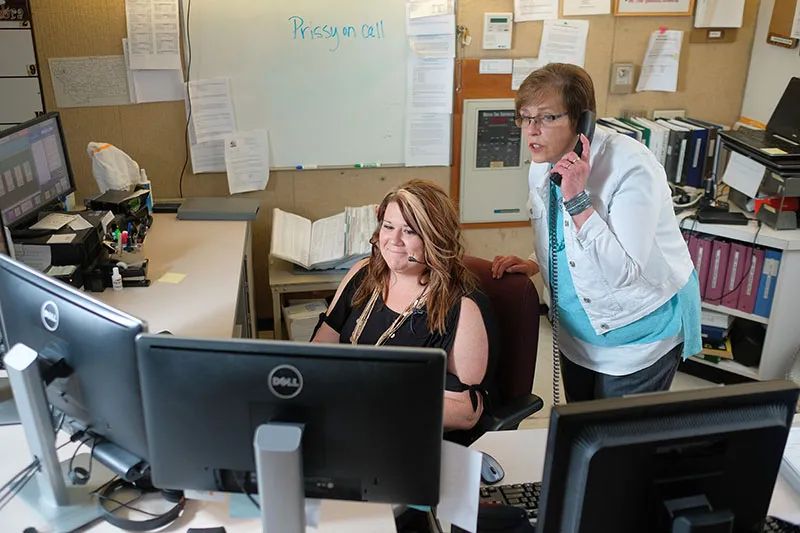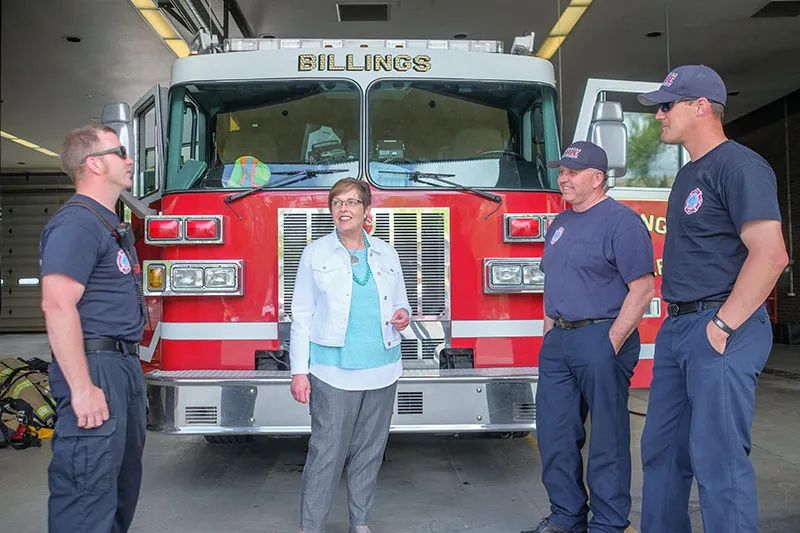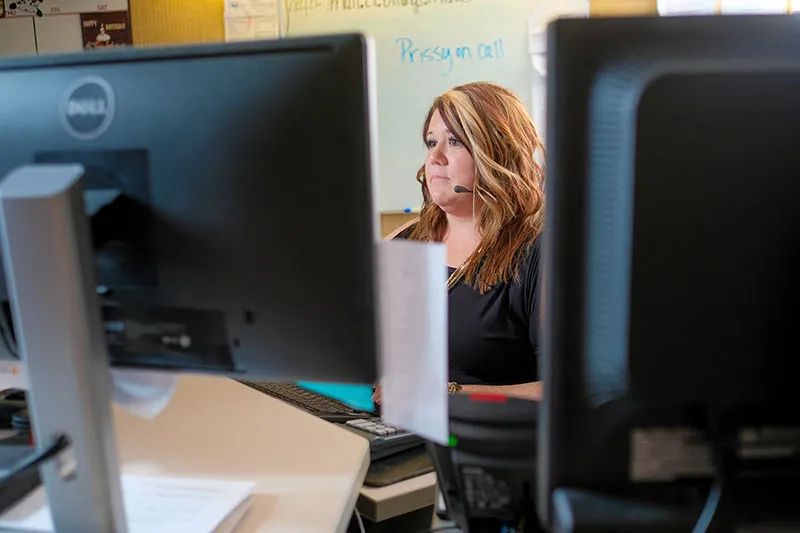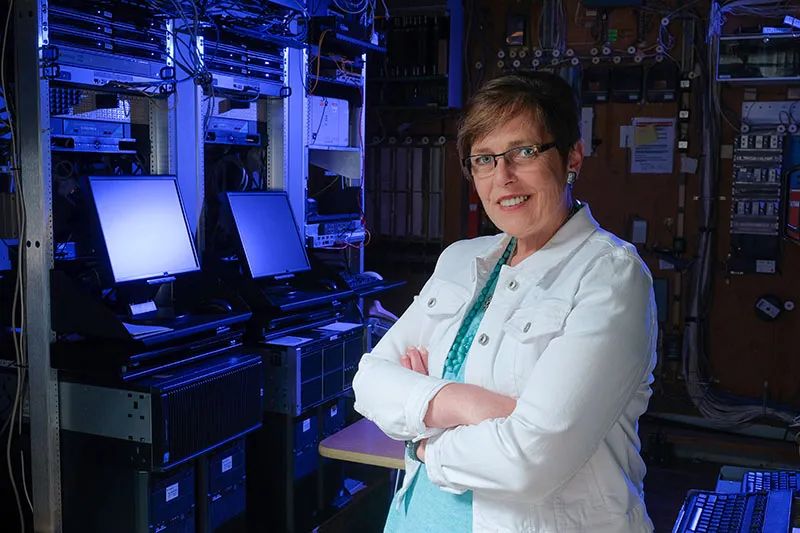
Cover Story: Answering the Call
The 9-1-1 Communication Center’s Anne Kindness
On the night set aside to visit with Anne Kindness about her job as the 9-1-1 Communications Center manager, it became clear this city servant is never truly off the job.
As my photographer and I watched her make her way across the street to meet us, we heard a man’s sudden screams, “You’re going to break my arm! Get off me!” More screams erupt and a woman shouts, “Give me back my $12!” A scuffle breaks out behind a hedge not far from the railroad tracks along Montana Avenue. Anne makes a beeline and, within seconds, is on her cell phone calling 9-1-1. While she knows the voice on the other end of the line extremely well, if a complication occurs during this public disturbance, the 9-1-1 dispatcher would be able to locate Anne’s cell phone thanks to technology she brought in for situations just like these.

Billings police officers arrive. The man and woman are broken apart and sent on their way in different directions. Anne brushes off her polished outfit and turns back to the issue at hand — talking about the highlight of her 33-year career: the construction of a state-of-the-art 9-1-1 communications center set to open this fall.
“This facility very well could be the facility that serves this community for the rest of my life and perhaps my children’s lifetime,” Anne says as she starts to share the details behind the 9,000-square-foot, $6 million construction project at 911 N. 24th St.
“We went 20 years without a staffing increase in 9-1-1. We desperately needed more bodies in here to handle the demand but we had no place to put them,” Anne says. Right now, six dispatchers fit in a space that’s less than 1,000 square feet. That might sound like ample room, but when you see the large desks, multiple computer screens and the full gamut of technology, it is cramped.
“This building is old,” says Diane Guy, one of the three 9-1-1 supervisors. “It’s falling apart. I think by the time we move across the street, it will be on its last legs. A lot has occurred in this room, but we are ready to let it go!”
Right now, the center handles 9-1-1 calls and two-way radio traffic for Billings fire, Billings police, the Yellowstone County Sheriff’s Office, American Medical Response and the airport’s fire and rescue team, as well as 15 rural fire departments in the area. There are only so many calls one dispatcher can take.
“We put people on hold 70,000 times in a year,” Anne says. “It’s not unusual for a dispatcher to be juggling three 9-1-1 calls at a time.” As Anne thinks about the new facility, “I will have 12 workstations in the new center. We are not going to be able to man all of them right away but we are going to be in much better shape, so hopefully, when someone picks up that 9-1-1 call, they can give that caller their full attention.”
What many consider incredible is the fact that the new center is being built without making a huge dent in the public safety budget. In fact, if you have a phone, you helped fund the project. Every land and cell phone line in the county is assessed a $1 emergency services fee each month. Seventy-five cents of that goes back to Yellowstone County. Over the course of 20 years, Fire Chief Bill Rash says, Anne Kindness and a few other city personnel became intense stewards of that 9-1-1 fund, squirreling away whatever they could to make this dispatch center a reality.

“They were able to take a percentage of that many years ago to begin putting that money into a capital improvement fund, which allowed for almost 100 percent of the funding of this new center. It is mind-boggling because it is just good stewardship,” Rash says. “I have known Anne for a little over 11 years. She has continually looked outside the box for better, more efficient ways of doing business. She has absolutely gone above and beyond.” He laughs as he adds, “You probably can’t tell that I am a big fan of hers.”
“We saved with a lot of sacrifice,” Anne says. “We could have used that 9-1-1 money to fund positions. We could have brought in more dispatchers but we elected to save that money and make capital purchases for technology and save some of it for the facility.”
While the new 9-1-1 center is the project of the moment, Rash will tell you Anne’s career has been sprinkled with plenty of advancements that have only helped strengthen this net of public safety.
“She started many, many years — more than 30 years ago — and everything then by today’s standard was archaic. She has self-educated, embraced every new piece of technology and every new practice for 9-1-1 centers and done a fantastic job,” he says.

When Anne started her career with the 9-1-1 center, she never intended to stay. Then 22 and a single mom, she took the job to move on from waitressing in the downstairs sandwich shop of the Hart Albin Department Store. Then City Councilwoman Marion Dozier, who had known Anne since her childhood, urged her to apply for the dispatch job.
“To tell you the truth, even when I came on, I thought that this would be a good filler thing while I figured out what I wanted to do with my life,” Anne says. But, as the months moved on to years, she realized she landed exactly where she was meant to be.
“It is something that gets in your blood,” Anne says. “There is something about this job that for the right personality and right temperament is intoxicating. You are there up front, close and personal. You are that first contact with people. There’s an awesome sense of responsibility in that.”
After six and a half years as a dispatcher, Anne quickly rose the ranks to assistant Communication Center manager. Three years after that, she earned the top management spot.
“I have been here since carbon paper,” Anne says with a laugh. “When I started, you handwrote reports on a triplicate form. You’d put your phone down and you’d run across the room and present your report to the appropriate dispatcher. We operated with three people in that back room.” When it came to training, she sat for three days observing before she was cut loose to answer calls on her own.

“Back in the day, we were pretty much considered clerical people,” supervisor Diane Guy says. “The evolution to what we are now occurred largely because of Anne. She recognizes the potential in people. She’s offered brilliant training and she insists on a level of service that is above and beyond what anyone would expect.”
Training wasn’t something Anne championed just for the Billings center. She literally wrote the curriculum for what’s called the 40-hour Communicator Basic — a baseline training for 9-1-1 center employees taught at the Montana Law Enforcement Academy. For years, she served as the lead instructor of the program, using her vacation days to head to Helena to teach up-and-coming dispatchers from every corner of the state. “I have a real commitment to the people who do this work,” Anne says. “There’s some emotional stamina that people need to do this job.”
Over the course of Anne’s career, she’s encountered nearly every type of call on the job. She’s been there when a dispatcher had to calm down a woman who claimed to have one-inch people living in her houseplants. She’s helped deliver babies over the 9-1-1 phone line. And, she’s been the last voice that at least a few people have heard in this life.
“There are calls that I took 30 years ago that still ring in me,” Anne says, reflecting on one in particular. “I picked up one 9-1-1 call and a man said, ‘My roommate shot himself. I need an ambulance.’ I asked him, ‘He shot himself? Is he breathing?’ The man said, ‘I don’t think so.’ I asked, ‘Where did he shoot himself?’ He told me, ‘He shot himself in the head. Lady, do you have an ambulance coming?’ and I said, ‘Yes, we are dispatching the ambulance now.’ Then, I heard the noise. I just remember saying, ‘Hello. Hello. Hello?’ I kept thinking, ‘What just happened?’ Three days later, there was the obituary. I thought, ‘Oh my God. I was the last person to speak to this man. What could I have done? Was there something I could have done?’” Anne says, “That’s the reality of the human experience. It gave me a heightened sense of how unpredictable things are, how lives just change on a dime.”
“Last year, we took almost 56,000 9-1-1 calls and we had 232,000 non-emergency calls”
~Anne Kindness, 9-1-1 Communication Center Manager
With the extreme lows come the incredible highs as well. Just recently, the staff welcomed a mom who came in to thank dispatchers for saving her 2-year-old daughter’s life.
“An entire chest of drawers fell on the 2-year-old. We had to do CPR with the mom over the phone to resuscitate her, which saved her. That mom, bless her heart, brought that little girl in with a plate of cookies for the dispatch staff,” Anne says. “Those are the moments you live for professionally because you don’t save everyone. The fact that this little girl gets to grow up? We own a little bit of that.”
Anne also “owns” many of the 9-1-1 center’s technological advancements over the last 20-plus years. She helped to bring in the emergency medical dispatch program, which certifies all 9-1-1 personnel to give life-sustaining instructions during medical emergencies. She pinpointed just the right software to make sure callers using cell phones could be found in the event of an emergency. She brought in enhanced 9-1-1, which automatically brings up the person’s name, address and phone number the second they place a 9-1-1 call. Anne even instituted a reverse 9-1-1 system so that a recorded announcement could be sent to phones in a threatened geographical area. This could come in handy should a hazard break out at one of the local refineries or if a wildland fire were to come dangerously close to residential areas. And then, there has been new radio technology installed to bridge analog and digital signals plus software used to enable a text to 9-1-1 services.
“I guess if I have a skill, it is just that I will roll my sleeves up, research and then, I just do it,” Anne says. “I am a forward-momentum type of person.”

On her office wall is a small calendar with the month December of 2019 circled. It’s the month she’s eyeing to end her career at the 9-1-1 center and move into retirement. Instead of counting down the days, Anne says, “I have it there to remind me that I don’t have a lot of time left to accomplish some of the things that I want to accomplish.”
As Anne talks about the next phase of life, construction can be heard buzzing right across the street. She’s just months away from making the move across the street and that time can’t come soon enough.
“I’m hoping to do a ribbon cutting on 9-11,” Anne says. Until that time, there’s much to be done. First and foremost is making sure the transition is fail-safe. Just like a heart that can’t stop beating, this communication network can’t skip a beat while the city moves from one system to the next. “I have to figure out how to get that service into the new facility without any interruption,” Anne says. “It is a doable deal but it is like walking a tightrope.”
Once that day comes and goes, Anne says she’ll figure out the operations and maintenance budget for the new facility and then ready herself to “hand over the keys” to someone else.
“I have a deep investment in all of this,” she says. “I know there comes a point when the old people need to get out of the way and let some of the young people spread their wings. I have been grooming people to spread their wings for years and I am excited for them.” As she looks around the center she adds, “These are incredible people doing a difficult and challenging job. They just do it so well. I am blown away by them.”
If you ask those who work alongside her, they will tell you without prompting that Anne’s shoes will be tough to fill at the state’s largest and busiest 9-1-1 center of operations.
“She has been a silent force for all of us. She’s increased wages. She’s increased the number of staff. She’s worked hard on our new 9-1-1 center, saving tirelessly through the 9-1-1 fund to take care of the purchase for the new building for us,” says 9-1-1 center supervisor Michelle Aman. “It’s a huge, huge, huge gift to this community and it is because of Anne that this is happening.”
Right now, Anne isn’t quite sure what she’ll pursue when time is all hers. She’s an incredible gardener. “Do you know anything about Cherokee purple tomatoes? They are the hot commodity right now,” she says, as she talks about the new heirloom varieties that she’s excited to grow. She is looking forward to the day when she’ll just roam her property in Ballantine that she shares with her husband, son and a few chickens (one she jokingly named Kung Pao). She has two grown children she’ll love to spend time with as well. She might try to use the liberal studies degree she earned in 2007 while working fulltime to explore creative writing. It feels as though the world is her oyster.
Regardless of what her next step may be, the calls, the people, the incidents she’s dealt with, the technology and the public safety she helped improve will be forever woven into who she’s become. “I’ve changed a lot since I was 22 years old,” Anne says. “There is a reward. There is a heady sense of ‘I make a difference.’ In the end, isn’t that what we all want?”

BILLINGS NEW COMMUNICATIONS CENTER
A look inside this new facility
When the city of Billings cuts the ribbon on the new 9-1-1 Communication Center, it will come with quite a bit more elbow room. The dispatch room is more than double the current size, and the center offers two decompression rooms to serve as a retreat if a dispatcher needs a few minutes of down time after answering a difficult call. The bathrooms are expanded and feature a shower for those times when staff is needed around the clock. Instead of a training desk, there’s a training room that comes complete with three stations. There’s an exercise space, two extra offices for growth, a conference room, a supervisor’s office plus a full-scale kitchen. 9-1-1 Communication Center manager Anne Kindness can’t wait to develop the space behind the center into a greenspace for dispatchers to enjoy with climbing flowers and benches. Why are these features so important for those who stand ready 24/7 to answer the emergency calls? Anne says, “Because these people spend a lot of time away from their families. I think these efforts go a long way to bring our team together.”
Is Your Cell Phone Ready for Emergencies?
Opt-in for critical notifications
When it comes to using reverse 9-1-1 to send recorded phone messages, alerting residents of a nearby emergency, most people don’t know you can register your cell phone to receive these calls. To date, only 3,261 residents have taken advantage of this service. To register your cell phone, visit ci.billings.mt.us, select the “Services” tab and then, under Public Safety, click on Emergency Notification Opt-In. You’ll need to create a username and password and give your address in order to register.
“Last year, we took almost 56,000 9-1-1 calls and we had 232,000 non-emergency calls”
~Anne Kindness, 9-1-1 Communication Center Manager















